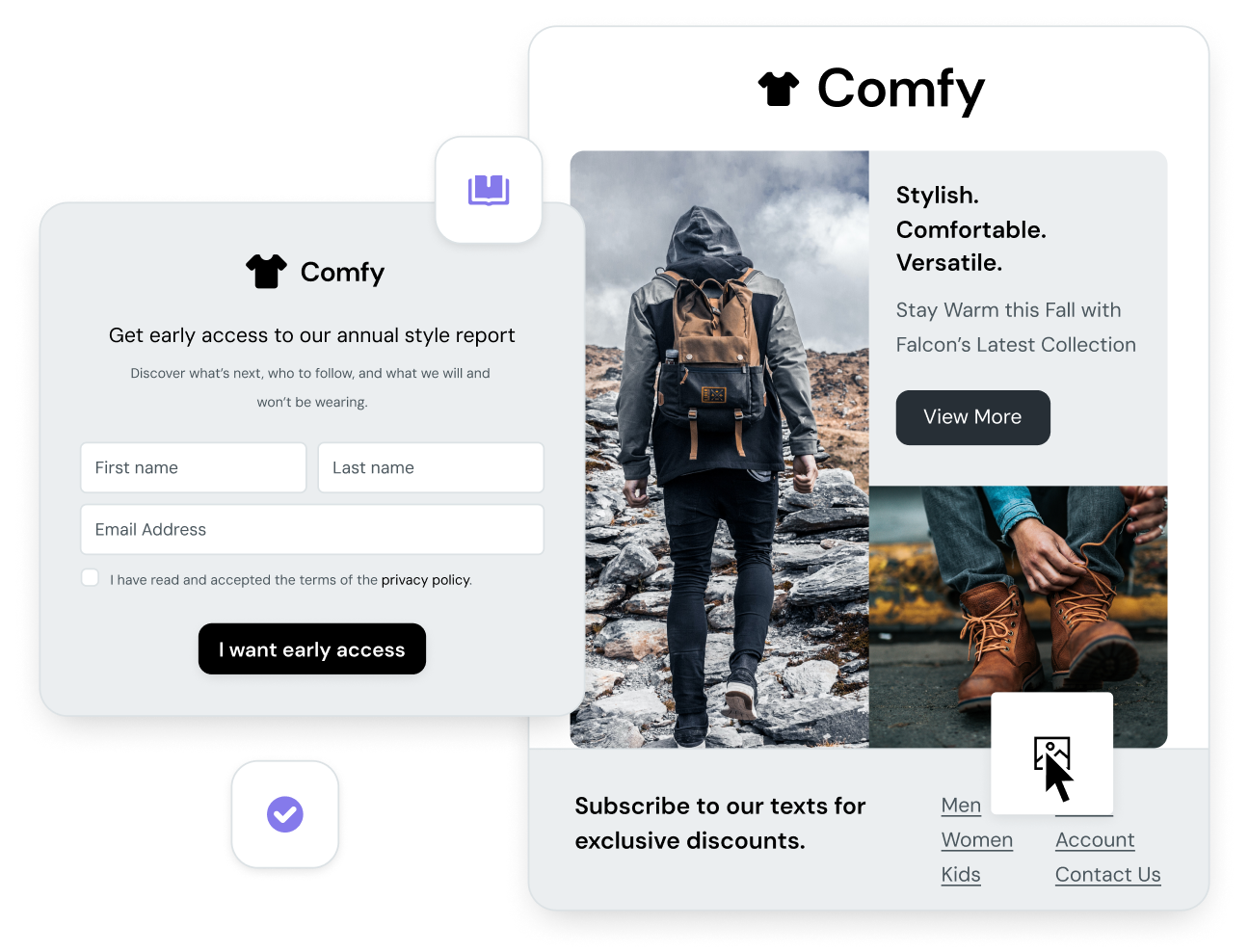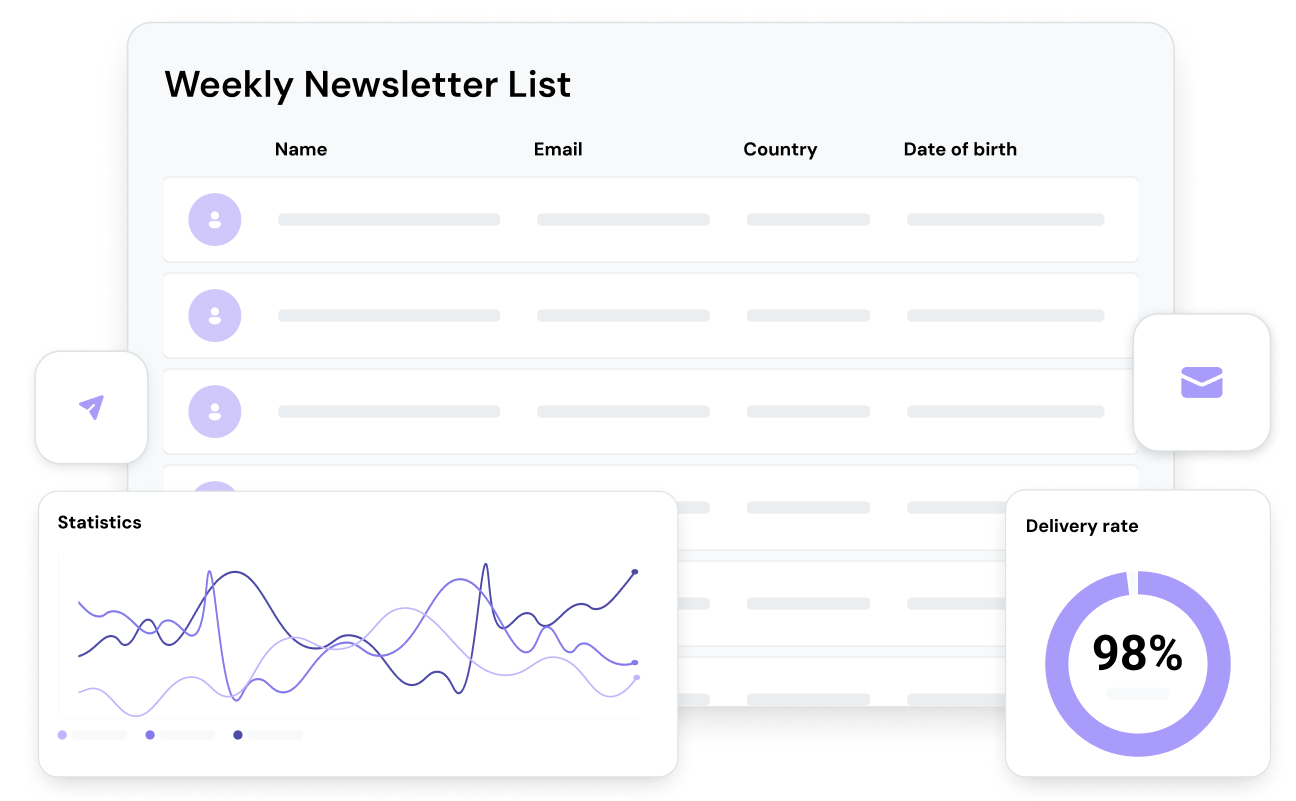Chapter 03
Growing a healthy contact list

Chapter 03

Let’s imagine your email program is a garden you’re trying to grow. Every email address you add to your contact database is like a seed. You’ll use marketing campaigns, newsletters, and customer communications to nurture those seeds with what they need.
Of course, you can also have bad seeds that will never grow. You can overwater or let weeds take over your garden. Before we get too far into this garden metaphor, let’s get something straight…
Deliverability begins before you send a single email. The ways you build and manage your contact lists can either help or hurt your efforts.
say they rarely or never conduct email list hygiene.
nearly 1 in 10 admit to acquiring contacts without obtaining permission to email them.
say they either don’t use or are unsure if they use a sunset policy for list hygiene.
believe a better sender reputation is the biggest benefit of prioritizing list hygiene.
Your email contact list is a valuable asset to your business. The people who’ve given you permission to reach them through their inboxes represent a direct line for revenue, brand building, and distribution of important customer communications.
But bigger isn’t always better – especially if you’ve built your list the wrong way.
Because email is such a powerful channel, some businesses take shortcuts when trying to build their contact lists. Two of the most common ways of doing that are by purchasing lists of email addresses and using software that scrapes the web to collect emails.
Email marketing is the most well-known form of permission-based marketing, which means people choose to opt in and have the freedom to opt out and unsubscribe at any time. At least, that’s what’s supposed to happen. Unfortunately, some senders either don’t realize or don’t care that obtaining consent is important.
Our survey found that 9.4% of respondents admit to either buying an email list or scraping websites for new contacts in the last two years.
The good news is that more than 85% are confident they have not used these shady list building methods, but that still means around 1 out of 10 legitimate senders may be emailing people without their consent.
The 9.4% of senders who use these questionable practices are spamming people. And spam is likely where their messages will start ending up. That’s because unethical list building is a risky business.
When sending transactional messages like order confirmations, invoices, password resets, and other one-to-one informational messages, the rules around permission are a bit different. Transactional emails only require implied consent, which means the recipient takes an action (like placing an order) that implies they’re willing to get messages about that action.
However, before you send any promotional messages, be sure to get consent.
Permission, consent, opting in, subscribing – call it what you want. The idea that recipients get to decide which brands are welcome in their inboxes is at the foundation of ethical email marketing.
If you expect your email program to be successful, build a contact list full of subscribers who want to engage with what you’re sending. One practice that helps make sure new subscribers want your emails is the double opt-in process.
What’s a double opt in?
With a double opt in, when a new contact signs up for your emails, they immediately receive a message asking them to confirm their intent to subscribe. The email will prompt them to click a link, and only after that happens are they officially added to your list.
Email marketers often debate whether to use a double opt in. Some feel it’s not always necessary, and it could mean your list doesn’t grow as quickly. However, email deliverability experts strongly recommend using a double opt in.
Our survey found nearly 40% of senders are using a double opt in to confirm new subscribers while 47.6% are not and 12.7% are unsure about their email sign-up process.
I would recommend that every sender use a double opt in all the time. Not only does it ensure you only acquire subscribers who are more likely to engage, but it also helps prevent bots from abusing signup forms, which is a significant email security risk.

Since most spambots can’t open and click emails, those addresses will never make it to your list. A double opt in also keeps your list clean because you’ll avoid adding invalid contact data (non-existent or mistyped emails) and spam traps.
An alternative to the double opt-in method involves segmenting new subscribers on a separate list. You email these contacts less frequently than your main list until it’s clear that they will open and click on your emails. This is sometimes called confirmed opt in lite (COIL).

There is a right way to build your email list, and as long as you get consent, there are also plenty of creative ways to make it happen. First, there are a couple of key components that make list building work: Landing pages and signup forms.
The landing page gives potential subscribers a reason to subscribe, and the form lets them give you permission to start sending emails. Here are a few types of landing pages you can create to encourage email signups.
1. Newsletter landing pages: Got great content you produce regularly? Ask your audience to sign up to receive a newsletter that delivers links to the latest articles, videos, and more.
2. Product landing pages: Releasing something your audience finds exciting? Grow your list by letting subscribers sign up for emails that make them among the first to know what’s new.
3. Exclusive deals landing pages: This works well if you’ve got an online store, a restaurant, or any business with the possibility of regular repeat purchases. Deliver coupon codes and discounts to subscribers to increase engagement and revenue.
Make signing up for your emails easy. Include forms in key places such as the footer of your website, the end of every blog post, or in a pop-up message. Use other venues and platforms, such as social media, in-person events, and webinars to encourage email opt ins.
Once your contact list has grown in size and been around for a while, things can get messy. To support good deliverability, you’ll need to do some housekeeping with regular list hygiene.
Remember that garden metaphor? List hygiene is like pruning dead leaves and pulling weeds out of your garden bed. Essentially, you are eliminating bad contact data and removing or segmenting subscribers who’ve stopped engaging with your emails.
When we asked survey participants how often they conduct list hygiene, we found there’s a wide range of timeframes.
While a combined 60% of senders clean their lists at least a couple of times per year, nearly 40% say they rarely or never conduct list hygiene.
Good list hygiene might be one of the things everybody forgets about, but it is so key to your success, and it’s something that can easily be done. You’re investing time and money into sending emails, and you want to make sure you’re taking care of the easiest things possible.

There will be people who lose interest in what you’re sending. Other people will abandon old email accounts or move to a different job, wasting space on your list.
In both these situations, you’ll see an overall decline in email engagement as those people stop opening and clicking. Regular list hygiene helps you drop the dead weight, and the good news is… keeping your contact list clean is not that hard to do.
What’s a sunset policy?
A sunset policy is a set timeframe for when you remove or segment unengaged subscribers from your contact list. For example, anyone who hasn’t opened or clicked an email in six months gets fewer emails from you or gets unsubscribed.
This supports deliverability because you are removing contacts who may not want your emails anymore.
One of the best ways to maintain a healthy contact list is to use a sunset policy to proactively unsubscribe or segment recipients who’ve stopped engaging.
Even though sunset policies are one of the most effective ways to conduct list hygiene, it’s a practice many senders have yet to adopt.
Our survey found only about 24% of respondents have a sunset policy for removing or segmenting unengaged subscribers. Nearly 59% have no policy and another 17% are unsure.
Sometimes, email marketers hesitate to remove unengaged subscribers. It’s tough to watch the size of your list decrease, and you probably wonder if there’s a chance those contacts would start engaging again.
That’s where a re-engagement email campaign comes in. Also known as a win-back campaign, this involves sending messages to inactive contacts in an attempt to regain their interest. Re-engagement campaigns may offer special deals, ask for feedback, or simply check in to see if people still want to be subscribed.
If you don’t win back those subscribers, it’s best to let them go. They weren’t doing you any good, and they’ll come back if they start missing what you were sending.
maintain sender reputation.
improved/accurate engagement metrics.
fewer spam complaints.
fewer unsubscribes.
While conducting list hygiene isn’t very complicated, it does take up time and resources. So, what are the advantages of having clean data and an up-to-date contact list?
Here are the four biggest benefits of list hygiene according to our survey of email senders:

The 47.5% of senders who believe sender reputation is a major benefit of list hygiene are absolutely right. Mailbox providers like Gmail, Yahoo Mail, and Outlook are paying close attention. If you’re sending to invalid contacts and your engagement rates are low, they may view you as an irresponsible sender who emails people things they don’t want. Before long, your email deliverability will suffer.
Managing your list based on engagement levels also reduces spam complaints and unsubscribes. That’s because you’ll notice when certain contacts are no longer interested and be able to take action before they mark your emails as spam. Remember, to most people, spam isn’t just unsolicited emails – it’s also unwanted emails.
Finally, if you want to view accurate email performance metrics, list hygiene is key. Invalid contacts and unengaged subscribers drag down metrics for opens, clicks, and conversions from email marketing.
What is email validation?
Email validation is the process of verifying that contact data (the email address) is legitimate. That means catching typos, fake/temporary emails, and outdated or inactive accounts. You can use email validation tools to verify new contacts at the point of signup or in bulk to clean up your entire list.
Perhaps the best way to keep a contact list clean is to prevent it from getting messy in the first place. Email validation tools help you do that.
It involves checking the syntax of each submitted email address to ensure it follows the correct format for a valid email address. This process helps weed out bad emails that might be entered incorrectly. Email verification services confirm the existence and validity of an email address through various checks, including domain verification and SMTP verification.
The way emails get verified is pretty technical. Here’s how our friends at Sinch Mailgun describe the email validation process.
Put simply, a validated email address follows the correct format, doesn’t have typos (like Gnail.com), and it’s confirmed that messages will be able to reach that contact.
Email validation is very beneficial. Yet, 28% of the senders we surveyed aren’t using any tools for email validation. That puts the health of your contact list at risk.
While organizations with large databases and high send volumes may want to consider Mailgun Validate for email verification, Sinch Mailjet users on paid plans can also get a set number of monthly validations built on the same technology.